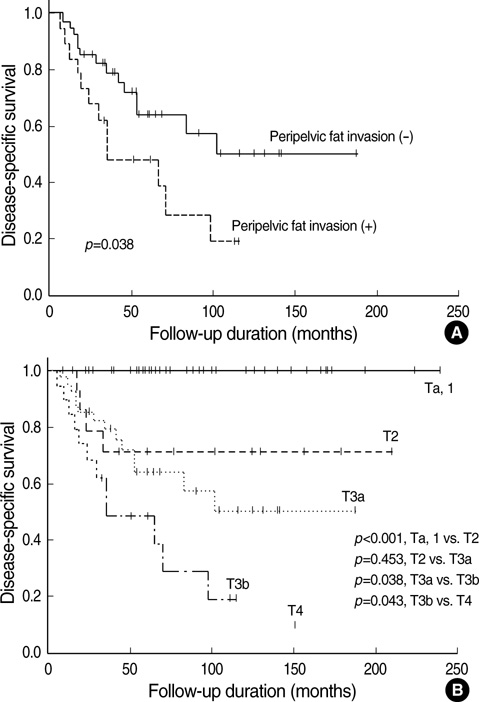J Korean Med Sci.
2008 Jun;23(3):434-438. 10.3346/jkms.2008.23.3.434.
Prognostic Impact of Peripelvic Fat Invasion in pT3 Renal Pelvic Transitional Cell Carcinoma
- Affiliations
-
- 1Department of Urology and Urological Science Institute, Yonsei University College of Medicine, Seoul, Korea. sjhong346@yuhs.ac
- 2Department of Pathology, Yonsei University College of Medicine, Seoul, Korea.
- 3Department of Urology, Inje University College of Medicine, Goyang, Korea.
- KMID: 1786881
- DOI: http://doi.org/10.3346/jkms.2008.23.3.434
Abstract
- Renal pelvic transitional cell carcinoma (TCC), which invades beyond muscularis into peripelvic fat or the renal parenchyma, is diagnosed as stage pT3 despite its structural complexity. We evaluated the prognostic impact of peripelvic fat invasion in pT3 renal pelvic TCC. Between 1986 and 2004, the medical records on 128 patients who were surgically treated for renal pelvic TCC were retrospectively reviewed. Sixty patients with pT3 disease were eligible for the main analysis. The prognostic impact of various clinicopathological factors was analyzed using univariate and multivariate analyses. On univariate analysis, sex, age, concomitant bladder tumors, concomitant ureter tumors, lymphadenectomy, adjuvant chemotherapy, tumor grade, multiplicity, renal parenchymal invasion, and carcinoma in situ did not influence the disease-specific survival (p>0.05). By contrast, peripelvic fat invasion, lymph node invasion, and lymphovascular invasion were each significantly associated with disease-specific survival (p<0.05). Multivariate analysis showed that peripelvic fat invasion (p=0.012) and lymph node invasion (p=0.004) were independent prognostic factors. In conclusion, peripelvic fat invasion is a strong prognostic factor in pT3 renal pelvic TCC. Thus, systemic adjuvant therapy should be considered in the presence of peripelvic fat invasion, even if the lymph nodes are not involved.
MeSH Terms
Figure
Reference
-
1. Huben RP, Mounzer AM, Murphy GP. Tumor grade and stage as prognostic variables in upper tract urothelial tumors. Cancer. 1988. 62:2016–2020.
Article2. Landis SH, Murray T, Bolden S, Wingo PA. Cancer statistics, 1998. CA Cancer J Clin. 1998. 48:6–29.
Article3. Murphy DM, Zincke H, Furlow WL. Primary grade 1 transitional cell carcinoma of the renal pelvis and ureter. J Urol. 1980. 123:629–631.
Article4. Cozad SC, Smalley SR, Austenfeld M, Noble M, Jennings S, Raymond R. Transitional cell carcinoma of the renal pelvis or ureter: patterns of failure. Urology. 1995. 46:796–800.
Article5. Hall MC, Womack S, Sagalowsky AI, Carmody T, Erickstad MD, Roehrborn CG. Prognostic factors, recurrence, and survival in transitional cell carcinoma of the upper urinary tract: a 30-year experience in 252 patients. Urology. 1998. 52:594–601.
Article6. Corrado F, Ferri C, Mannini D, Corrado G, Bertoni F, Bacchini P, Lelli G, Lieber MM, Song JM. Transitional cell carcinoma of the upper urinary tract: evaluation of prognostic factors by histopathology and flow cytometric analysis. J Urol. 1991. 145:1159–1163.
Article7. Park S, Hong B, Kim CS, Ahn H. The impact of tumor location on prognosis of transitional cell carcinoma of the upper urinary tract. J Urol. 2004. 171:621–625.
Article8. Kikuchi E, Horiguchi Y, Nakashima J, Hatakeyama N, Matsumoto M, Nishiyama T, Murai M. Lymphovascular invasion independently predicts increased disease specific survival in patients with transitional cell carcinoma of the upper urinary tract. J Urol. 2005. 174:2120–2123.
Article9. Das AK, Carson CC, Bolick D, Paulson DF. Primary carcinoma of the upper urinary tract. Effect of primary and secondary therapy on survival. Cancer. 1990. 66:1919–1923.
Article10. Greene FL, Page DL, Fleming ID, Fritz AG, Balch CM, Haller DG, Morrow M. AJCC Cancer Staging Manual. 2002. 6th ed. New York: Springer Verlag;329–331.11. Olgac S, Mazumdar M, Dalbagni G, Reuter VE. Urothelial carcinoma of the renal pelvis: a clinicopathologic study of 130 cases. Am J Surg Pathol. 2004. 28:1545–1552.12. Yoshimura K, Arai Y, Fujimoto H, Nishiyama H, Ogura K, Okino T, Ogawa O. Prognostic impact of extensive parenchymal invasion pattern in pT3 renal pelvic transitional cell carcinoma. Cancer. 2002. 94:3150–3156.
Article13. Epstein JI, Amin MB, Reuter VR, Mostofi FK. The World Health Organization/International Society of Urological Pathology consensus classification of urothelial (transitional cell) neoplasms of the urinary bladder. Bladder consensus conference committee. Am J Surg Pathol. 1998. 22:1435–1448.14. Guinan P, Volgelzang NJ, Randazzo R, Fremgen A, Chmiel J, Sylvester J, Sener S. Renal pelvic transitional cell carcinoma. The role of the kidney in tumor-node-metastasis staging. Cancer. 1992. 69:1773–1775.
Article15. Ozsahin M, Zouhair A, Villa S, Storme G, Chauvet B, Taussky D, Gouders D, Ries G, Bontemps P, Coucke PA, Mirimanoff RO. Prognostic factors in urothelial renal pelvis and ureter tumours: a multicentre Rare Cancer Network study. Eur J Cancer. 1999. 35:738–743.
Article16. Grabstald H, Whitmore WF, Melamed MR. Renal pelvic tumors. JAMA. 1971. 218:845–854.
Article17. Rubenstein MA, Walz BJ, Bucy JG. Transitional cell carcinoma of the kidney 25-year experience. J Urol. 1978. 119:594–597.
Article18. Jewett HJ, Strong GH. Infiltrating carcinoma of the bladder: Relation of depth of penetration of bladder wall to incidence of local extension and metastases. J Urol. 1946. 55:366–372.19. Beahrs O, Henson D, Hutter R, Myers M. Manual for staging of cancers. 1988. Philadelphia, USA: Lippincott;205–207.
- Full Text Links
- Actions
-
Cited
- CITED
-
- Close
- Share
- Similar articles
-
- Prognostic Impact of Parenchymal Invasion Pattern and Adjuvant Chemotherapy in pT3 Transitional Cell Carcinoma of the Renal Pelvis
- Pathologic Classification by Intraductal Involvement and Parenchymal Invasion of Transitional Cell Carcinoma in the Renal Pelvis
- Prognostic Significance of Renal Pelvic and Medullary Invasion in Renal Cell Carcinoma
- A Case of Excessive Proliferation of Peripelvic Fat of Kidney Simulating Peripelvic Liposarcoma
- The Diagnostic Usefulness of Computed Tomography of Transitional Cell Carcinoma of the Renal Pelvis and Ureter


